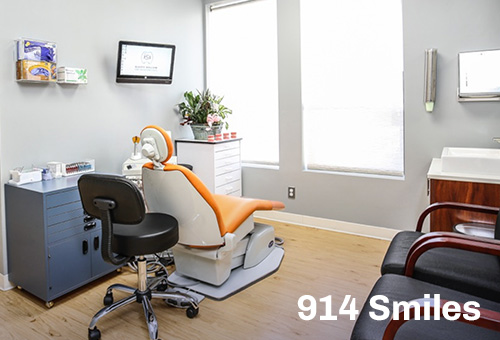
Braces and Invisalign are both amazing tools for straightening the teeth and aligning the bite. Yet, as miraculous as they are, they can’t always do all of the heavy lifting by themselves and often need a little help from other tools or appliances. Among the accessories we use most frequently, are braces rubber bands, or more accurately, orthodontic rubber bands since they can also be combined with clear aligners. The term can be a bit confusing considering there are actually different braces elastics types.
You have the tiny elastics, known as ligatures, that wrap around each bracket to keep the archwire in place. Then, you also have the bigger rubber bands that guide the teeth into their final position. Today, we’ll be going over the ins and outs of the latter. Here’s the 914 Orthodontics guide to rubber bands and braces and how they help with the teeth-straightening process.
What are Orthodontic Rubber Bands and How do They Work?
Braces and Invisalign both exert continuous pressure to gently and steadily move the teeth and jaws into place. Yet, they straighten the top and bottom teeth and jaws independently of one another. Ultimately, having proper alignment means your teeth fit together correctly when you bite down. In certain cases, achieving this ideal relationship between the upper and lower arch requires using connective forces. Rubber bands can provide this force and give the system a little extra oomph to encourage teeth to shift in specific ways.
Braces rubber bands look a lot like they belong at an office supply store. However, these aren’t your run-of-the-mill elastics or hair ties (believe it or not, there’s a dangerous trend of people creating DIY braces out of hair ties and other household items). They’re made from strong, durable, medical-grade latex – or an alternative material for people with latex allergies – that’s safe to have in your mouth and won’t irritate your gum tissue.
If you’re wearing clear or metal braces, your brackets will have hooks that are used to attach the rubber bands. If you’re perfecting your smile with Invisalign, the rubber bands can be stretched around clear buttons that are bonded directly to the teeth. While it’s a topic for another post, a lot of our Sleepy Hollow Invisalign patients are surprised to learn that most people require these low-profile attachments in conjunction with their aligners.
You’ll typically wear braces or Invisalign for a few months before we add elastics to your treatment. We have tooth-colored rubber bands that will blend right in or if you want to go bold, we can do colored ones as well. The braces elastics positions vary depending on the goal we’re aiming for. For example, to correct an overbite, we’ll usually stretch the elastics around the hooks on the upper canine teeth (the pointy ones) and the hooks on the bottom first molars.
Rubber bands for an underbite will go the opposite way and run from the lower front teeth to the upper back teeth. Rubber bands can also be configured in a triangle, rectangle, across the front of the mouth or other formations. Their versatility is one of the things we love about them. So, how long do you need to wear braces rubber bands? It depends on your individual needs. Once we get the right amount of correction, you’ll be able to stop wearing them. For some people, this can happen in several months and for others, it could take a year.
For the best results, Dr. Kothari usually has patients wear them all day, every day, taking them out only to brush and floss, eat and change them. Since they lose their elasticity, which decreases the amount of force they’re applying, they might need to be swapped out a few times a day.
When do you start wearing rubber bands for braces?
Rubber bands, also known as elastics, are usually introduced at different stages of your braces journey, depending on your specific dental needs. Some people start wearing them a few months into their treatment, while others might begin later. Your orthodontist will decide the best time based on how your teeth are moving and how your bite is aligning. These small but mighty bands play a key role in making sure your teeth move to the right spots and your bite is just right. It’s important to wear them exactly as your orthodontist tells you, to get the best results. Regular check-ups will help you know when to start using them and how to wear them properly.
The Dos and Don’ts of Wearing Rubber Bands and Braces
The idea of being in charge of your rubber bands each day can be overwhelming but you’ll be a pro in no time and, of course, we’ll go into more detail about how to attach them, how often to wear them and what to do in case of a problem. In the meantime, these general dos and don’ts should help clarify some of your questions.
DO follow your orthodontist’s rubber band directions exactly. Their effectiveness is completely based on compliance. If you don’t wear them for the prescribed amount of time and change them as directed, your teeth will relapse and you could make your orthodontic treatment last longer. Even though our office is pretty awesome, you probably have other things you’d rather be doing than coming in for appointments.
DON’T take your elastics off if your teeth are sore. Every time you remove them for an extended period and put them back on, you’re starting the adjustment period and any related discomfort over again. We promise, you’ll get used to wearing them quickly and soreness will go away.
DO wear them about 23 hours a day, seven days a week (taking them out to brush, floss, eat or wear a mouthguard) unless otherwise instructed.
DON’T get too overzealous when putting them on because stretching them out will decrease their effectiveness.
DO bring some extra rubber bands along with you in case one breaks or gets lost. If this happens, always replace both rubber bands to ensure equal tension on either side of your mouth. It’s a good idea to store the bulk of your rubber bands in a designated area in your home and put some in baggies to keep in your desk or locker, in the car or anywhere else you frequent so you’re always prepared.
DON’T double up on rubber bands or try to modify them in any way in an attempt to get them to work faster. Moving the teeth with orthodontic treatment involves biological forces and too much pressure can cause serious harm and potentially damage the roots of your teeth.
DO call the office if you forget how to put them on or you’re running low.
DON’T use any rubber bands other than the ones you were given by your orthodontist. We’ve been asked where to buy rubber bands for braces and the answer is, nowhere! Treatment is customized to your mouth and we use a specific type of rubber band. It’s very likely that random elastics will be unsafe and won’t work.
Handling Orthodontic Elastics Mishaps
After a few weeks, putting on your rubber bands will become second nature and you won’t think twice about it. Since they’re so stretchy and don’t impede the movement of your jaw, they’re comfortable and easy to wear. Yet, here and there, you could have a very minor issue such as:
Sensitive teeth and jaws – It’s possible for the teeth and jaws to be a little achy for a day or two when you first start wearing rubber bands. This is a good sign and means they’re working. Any discomfort will be extremely minor. If necessary, you can take an over-the-counter pain reliever, like Tylenol.
A broken or missing rubber band – Should an elastic pop off or break, replace both of the rubber bands with new ones. If you forgot to bring extras, be sure to put them on as soon as you have access to them. If you have to go for a long time without them, let us know so we can adjust your treatment if we have to.
Blanking on the instructions – If you forget Dr. Kothari’s instructions for how to attach your rubber bands after you leave the office, don’t beat yourself up about it or be afraid to contact us. It’s important to put them on right so your teeth move according to plan. Call us, text us, email us or send us a Facebook message and we’ll walk you through it again.
Comfortable, cost-effective, versatile, easy to get the hang of using and a way to accomplish dramatic results. What’s not to like about rubber bands? However, they aren’t for everyone and some patients will need to take a different route to safely and effectively correct misalignment. That’s where an experienced orthodontist comes in.
Dr. Kothari has the knowledge and training to bring out the best in your smile and if the approach involves orthodontic rubber bands, the 914 Orthodontics team will help you use them as efficiently as possible. We offer a variety of orthodontic treatments including Invisalign and braces in Tarrytown, Sleepy Hollow, Briarcliff, Ossining and the surrounding area.




